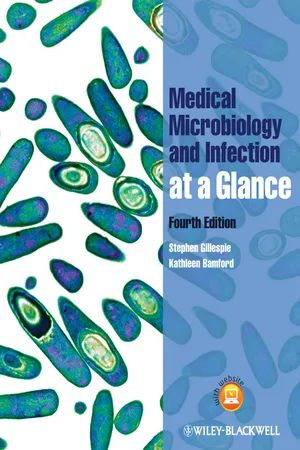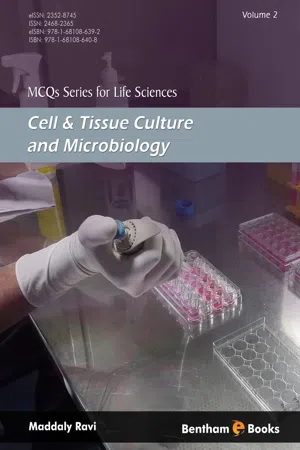Bacteria Cell Wall
The bacterial cell wall is a rigid structure that surrounds the cell membrane of bacteria, providing shape, support, and protection. It is primarily composed of peptidoglycan, a unique molecule that gives the cell wall its strength and stability. The cell wall also plays a crucial role in protecting bacteria from environmental stresses and maintaining their overall integrity.
5 Key excerpts on "Bacteria Cell Wall"
- eBook - ePub
- Stephen H. Gillespie, Kathleen B. Bamford(Authors)
- 2012(Publication Date)
- Wiley-Blackwell(Publisher)
...1 Structure and classification of bacteria Bacterial classification is important, revealing the identity of an organism so that its behaviour and likely response to treatment can be predicted. Bacterial Structural Components Bacterial cell walls are rigid and protect the organism from differences in osmotic tension between the cell and the environment. Gram-positive cell walls have a thick peptidoglycan layer and a cell membrane, whereas Gram-negative cell walls have three layers: inner and outer membranes, and a thinner peptidoglycan layer. The mycobacterial cell wall has a high proportion of lipid, including immunoreactive antigens. Bacterial cell shape can also be used in classification. The following cell components are important for classification, pathogenicity and therapy. Capsule : a polysaccharide layer that protects the cell from phagocytosis and desiccation. Lipopolysaccharide : surface antigens that strongly stimulate inflammation and protect Gram-negative bacteria from complement-mediated lysis. Fimbriae or pili : specialized thin projections that aid adhesion to host cells. Escherichia coli that cause urinary tract infections bind to mannose receptors on ureteric epithelial cells by their P fimbriae. Fimbrial antigens are often immunogenic but vary between strains so that repeated infections may occur (e.g. Neisseria gonorrhoeae). Flagella : these allow organisms to find sources of nutrition and penetrate host mucus. The number and position of flagella may help identification. Slime : a polysaccharide material secreted by some bacteria that protects the organism against immune attack and eradication by antibiotics when it is growing in a biofilm in a patient with bronchiectasis or on an inserted medical device. Spores : metabolically inert bacterial forms adapted for long-term survival in the environment, which are able to regrow under suitable conditions. Bacteria have a single chromosome and lack a nucleus (prokaryotes)...
- eBook - ePub
- Vincent A. Fischetti, Richard P. Novick, Joseph J. Ferretti, Daniel A. Portnoy, Mirian Braunstein, Julian I. Rood, Vincent A. Fischetti, Richard P. Novick, Joseph J. Ferretti, Daniel A. Portnoy, Mirian Braunstein, Julian I. Rood(Authors)
- 2019(Publication Date)
- ASM Press(Publisher)
...For example, the introduction of cryo-focused ion beam (cryo-FIB) combined with a scanning electron microscope (cryo-FIB-SEM) as a new close-to-nature approach was sold a few years after the first advent of FIB-SEMs for conventional resin-embedded biological samples. THE BACTERIAL CELL WALL Bacteria are mostly unicellular organisms which can be found in a wide variety of environments. Therefore, bacterial cell walls deserve special attention because they (i) provide the essential structure for bacterial viability by protecting against the often hostile environment, (ii) are composed of unique components found nowhere else in nature, (iii) are responsible for the shape of the bacteria, (iv) provide a halt for ligands and proteins for adherence to host cells, (v) expose receptor sites for drugs or viruses, (vi) represent the most important sites for attack of antibiotics, (vii) provide structures for immunological distinction and variation, and (viii) can cause symptoms of disease in animals and humans. Chemistry of the Bacterial Cell Wall Backbone The major backbone of the bacterial cell wall is the peptidoglycan, also called murein, which consists of repeating linear units of the disaccharide N -acetylglucosamine (NAG) linked to N -acetylmuramic acid (NAM). The disaccharides are cross-linked via often flexible pentapeptide amino acid chains forming a mesh-like framework (17). Chemically, the peptidoglycan consists of alternating β-1,4-linked N -acetylglucosamine (GlcNAc; NAG) and N -acetylmuramic acid (MurNAc, NAM, a variant of GlcNAc with a d -lactate attached to the C-3 by an ether bond). Termination of a peptidoglycan strand is achieved at the reducing end by a 1,6-anhydroMurNAc residue, in which the C-1 and C-6 of the sugar backbone are bound through an ether linkage. The appearance of the unusual 1,6-anhydroMurNac is used to determine the end of the strands...
- eBook - ePub
Handbook of Microbiology
Condensed Edition
- Allen I Laskin(Author)
- 2019(Publication Date)
- CRC Press(Publisher)
...The most important of them is undoubtedly peptidoglycan (mucopeptide, murein), since it is responsible for the structural integrity of the cell in the face of its internal osmotic pressure. Peptidoglycan is present in bacteria of all kinds, except the extreme halophiles where the osmotic pressure of the environment presumably makes it unnecessary. It is also present in Spirillum, Spirochaeta, Rickettsia, and blue-green algae, but not in viruses, yeasts, fungi, higher plants, or animals. It is therefore confined to the cell wall of prokaryotic cells. Peptidoglycan forms a large proportion of the wall in Gram-positive organisms, where it may make up 50% or more of the wall’s dry weight. In Gram-negatives, on the other hand, it forms usually less than 10% of the wall and sometimes as little as 1%. These differences are largely responsible for the higher proportion of amino sugars in the walls of Gram-positives. In the electron microscope the difference in appearance of cross sections of the wall in Gram-positives and Gram-negatives is generally rather obvious (Figure 1). The typical Grant-positive wall shows a thick (200 -500 Å), featureless structure inside which is the double-track (dark-light-dark) appearance of the cytoplasmic membrane. The typical Gram-negative wall, however, is generally thinner (100—150 Å) and shows two double-track membranes separated by a space in which an intermediate layer may or may not be visible (Figure 1. lib). The inner of the two double-track structures is the cytoplasmic membrane, and the intermediate layer is almost certainly the peptidoglycan. These “typical” appearances may vary considerably in different organisms and with different methods of fixation. 23 - 26 Peptidoglycan Peptidoglycan is a polymer with a backbone of amino sugar chains which are cross-linked through letrupeptide side chains. An idealized diagram of the structure is given in Figure 2...
- eBook - ePub
Immunology
Mucosal and Body Surface Defences
- Andrew E. Williams(Author)
- 2011(Publication Date)
- Wiley(Publisher)
...This allows for the rapid uptake of molecules and expulsion of waste products and easy distribution of nutrients throughout the cell. Gram-positive bacteria have only one plasma membrane, which is surrounded by a cell wall composed of many layers of peptidoglycan. Gram-negative bacteria are slightly more complex. They too have an inner membrane surrounded by a few layers of peptidoglycan but in addition have an outer membrane, which itself is surrounded on the outside by a layer of lipopolysaccharide (LPS). The space between the inner and outer membranes is known as the periplasm, which is composed of lipoproteins and enzymes as well as peptidoglycan (Figure 12.1). The components of the bacterial cell wall are highly immunogenic and often provide the immune system with very important signals during the induction of an immune response. However, some pathogenic bacteria have capsules that surround the entire cell, comprising mostly of carbohydrates, which often inhibit recognition by the immune system, or render them less susceptible to immune attack. Bacteria do not possess a defined membrane-bound nucleus; rather the genetic material is carried on a single chromosome of circular DNA that is retained in a cellular region known as the nucleoid. Some bacteria also carry additional genetic material on small, circular pieces of DNA called plasmids that replicate independently of the chromosome. These plasmids are useful for transferring genetic information from one bacterium to another and often encode antibiotic resistant genes or genes that encode toxins. The cytoplasm of bacteria is full of ribosomes, which translate messenger RNA into many functional proteins. However, unlike eukaryotic cells, bacteria do not possess an endoplasmic reticulum, Golgi complex or mitochondria. In addition, certain bacteria have appendages known as pili, which are responsible for transporting plasmids and chromosomal DNA across the plasma membranes of adjacent cells...
- eBook - ePub
- Maddaly Ravi(Author)
- 2018(Publication Date)
- Bentham Science Publishers(Publisher)
...Microbial Structure and Function Maddaly Ravi The dense coat of bacteria, if present is called Cell wall Capsule Plasma membrane Envelop Loosely associated external bacterial coat is called Cell wall Capsule Slime layer Envelop Bacterial capsules and slime layers are composed of Proteins and polysaccharides Only proteins Only polysaccharides Neither proteins nor polysaccharides Bacterial strains that are referred to as “smooth” contain Capsules Cell walls Envelop Slime layer Bacterial strains that are referred to as “smooth” do not contain Capsules Cell walls Envelop Slime layer Capsules function for Staining bacteria Increasing the pathogenicity of bacteria Identifying bacteria Culturing Bacteria Cell Walls of bacteria are also known as Capsules Membrane Envelop Slime layer The most abundant bacterial cell wall component is Peptidoglycan Dextrose Starch Cellulose The number of peptidoglycan layers that Gram-positive bacteria have. is 10-50 5-10 1-5 4 The number of peptidoglycan layers that Gram-negative bacteria have is 1-4 2-10 1-2 5-10 The shape of Gram-positive bacteria is Rigid Flexible Can be rigid or flexible No definite shape The shape of Gram-negative bacteria is Rigid Flexible Can be rigid or flexible No definite shape The Gram-positive bacteria are usually Rods only Cocci only Rods and cocci Spirals The Gram-negative bacteria are usually Rods Rods and cocci Rods, cocci and spirals Rods, cocci, spirals and pleomorphic Spore formation occurs in Gram-positive bacteria Gram-negative bacteria Both Gram-positive and –negative bacteria The Gram-staining does not matter Spore formation does not commonly occur in Gram-positive bacteria Gram-negative bacteria Both Gram-positive and –negative bacteria The Gram-staining does not matter Penicillin has a greater inhibitory potential on Gram-positive bacteria Gram-negative bacteria Both Gram-positive and –negative bacteria The Gram-staining...




